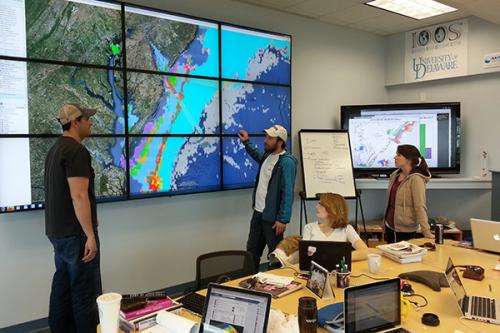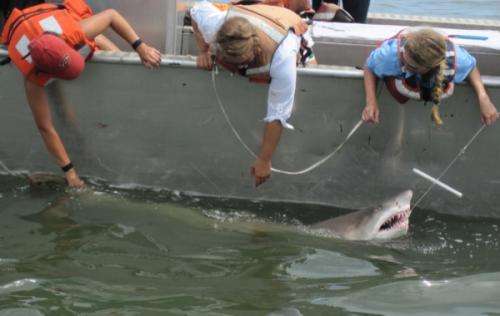Researchers developing fishing forecast to help watermen avoid vulnerable species

When fishermen are at sea to catch monkfish, fluke or other commercial seafood, much larger fish can unintentionally wind up in their nets. Hauling in sand tiger sharks and Atlantic sturgeon can be particularly problematic—not only are they big, they are protected by strict regulations.
Researchers from the University of Delaware and Delaware State University are developing an innovative daily fishing forecast—similar to a weather report—that could help watermen avoid accidentally catching sharks and sturgeon as bycatch.
"Based on environmental observations in real-time, we are going to make probability predictions of those two species to give another layer of information to fishermen," said Matt Oliver, assistant professor of oceanography in the University of Delaware's College of Earth, Ocean, and Environment (CEOE).
Atlantic sturgeon are endangered south of New England, with populations dwindling and harvesting prohibited under a government-regulated recovery plan. Sand tiger sharks are also illegal to catch and were identified as a "species of concern" by the National Marine Fisheries Service in 1997. Gear modifications and fishery restrictions have helped reduce, but not end, bycatch.
To create the fishing forecast, researchers are crunching huge amounts of oceanographic and biological data with supercomputers to look for connections between environmental conditions and migration patterns.
Delaware State University's Dewayne Fox already has a complex system in place for following fish movement offshore Delaware in what is one of the most heavily instrumented areas in North America. Fox and Oliver will examine nearly a decade's worth of information collected there from sharks and sturgeon tagged with tracking devices for previous research efforts.

The data show where and when the species traveled coastal waters, and documentation from regulators on landings farther off the coast will also be included in the study.
The scientists will then cross-reference the animals' past whereabouts with historic satellite data on what the ocean conditions, such as water temperature and salinity, were at those times and locations. Trends that emerge could help paint a comprehensive picture of shark and sturgeon's preferred habitat, which can then be used to make future predictions.
"Our goal is to use existing data sets as well as tracking data that we've been collecting to try to predict where these animals are more likely to be," Fox said. "That way, the fishermen can make informed decisions."
Fishermen, after all, are attuned to finding fish—not avoiding certain species. The forecasts will give them an additional tool in choosing where to direct their efforts. Daily reports will be available online, with maps showing where the risk for encountering protected species is higher or lower.
"That real-time component is something really unique," said Charlotte Hudson, director of the Lenfest Ocean Program, the funder of the project through a three-year grant.
Oliver and Fox will draw on satellite feeds with oceanographic information from the Mid-Atlantic Regional Association Coastal Ocean Observing System (MARACOOS), which uses satellites, underwater robots and models to study the coastal ocean. MARACOOS Executive Director Gerhard Kuska helped connect the researchers with Lenfest, and he views the project as a potential win-win for fishermen and regulators.
"There's a great conservation benefit that also serves the fishing community," said Kuska, who also serves on the CEOE Dean's Advisory Council. "We're helping fishermen avoid species they don't want to be catching."
When the first forecasts are ready in a few years, fishermen will help test the model's accuracy. The researchers will provide the fishermen with a forecast and ask them to fish areas where they don't think the sharks and sturgeon are, but where they still might be able to catch commercial species. Then they will ask the fishermen to go to an area where they do not think the fish are—and see if they are right.
The effort builds on the researchers' earlier work combining fish ecology with oceanography. Oliver previously was involved in a project aiming to reduce butterfish bycatch, and last year he and Fox used an underwater robot to find tagged sturgeon and sample water conditions there.
The forecast project, however, is using a much larger set of data, and would be a first for these species. If successful, the approach could be modified and applied to other animals where tagging data is available, informing conservation efforts.
"This project is about sharks and sturgeon, but if we can prove this works, it could also be used for marine mammals and other protected species," Fox said.
More information: For more information, see the project website: www.lenfestocean.org/project/d … es-bycatch-avoidance
Provided by University of Delaware


















